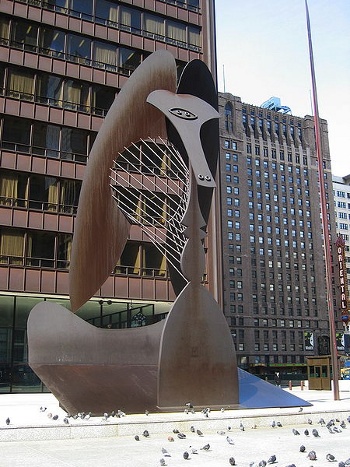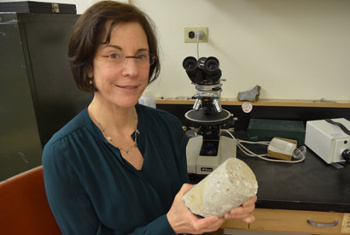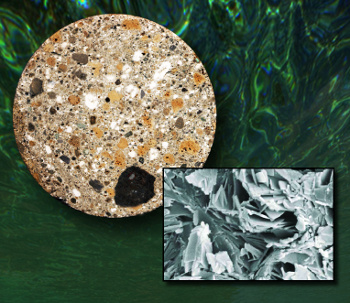In Search of... Ancient Concrete
July 1, 2013
In between the
original Star Trek television series and the later upsurge in Star Trek popularity,
Leonard Nimoy hosted a
syndicated television series entitled, "
In Search of..., from 1976-1982." The show presented information about controversial, mysterious and
paranormal phenomena in both
historical times and the present day.
Extraterrestrial visitors to
Earth were a common topic in this series, and there were episodes about the
Bermuda Triangle, the
Loch Ness Monster and the
Lost Colony of Roanoke. Each episode contained the subject in its title; for example, "In Search of... Ancient Astronauts." It was very entertaining, in a
supermarket tabloid sort of way, and I watched nearly all of them.
One part of the series I remember is the
disclaimer, which could be appended to many of today's
scientific publications.
"This series presents information based in part on theory and conjecture. The producer's purpose is to suggest some possible explanations, but not necessarily the only ones, to the mysteries we will examine."
Nimoy was especially dedicated to his new television series. He even wrote an episode (Season 4, Episode 16, January 10, 1980) about the life of the
artist,
Vincent van Gogh. Nimoy's research uncovered van Gogh's medical records, which suggested that the artist may have suffered from
epilepsy, and not
insanity. I think that a
severed ear counts as insanity, especially when it's your own.

Vincent van Gogh (1853-1890), self-portrait with pipe and bandaged ear, 1889, oil on canvas.
(Via Wikimedia Commons.)
One possible episode could have been entitled, "In Search of Ancient Materials." As one example, our ancestor
materials scientists had a good understanding of
metals. After all, someone in the distant past was the first to
smelt iron, which is a considerable
technical feat.
Unfortunately,
iron tends to
rust, so modern
metallurgy has produced
stainless steel; and also
weathering steel (trade name, CORTEN Steel), which develops a protective rust-like coating that prevents further corrosion and is a favored medium for many
sculptors.

Untitled 1967 sculpture in CORTEN steel by Pablo Picasso.
The sculpture is located in Daley Plaza, Chicago.
The sculpture cost about $350,000 to make, and Picasso refused an offered $100,000 commission, instead gifting it to the people of Chicago.
(Photograph Copyright 2006 by Jeremy Atherton, published under the Creative Commons Attribution-Share Alike 2.5 Generic license via Wikimedia Commons.)
Lest we feel too smug in our ability to make non-rusting iron, there's a 6.5 ton
iron stele in
Delhi,
India, known as the
Iron pillar of Delhi, that's stood uncorrupted for about 1600 years.[1] This huge pillar, which is about seven
meters (23
feet) high and tapers from a
diameter of about a meter at its base to about 0.7 meters at the top, was created by
forge welding individual pieces. The key to its corrosion resistance is the iron's high
phosphorous content. Phosphorous is one of the ingredients of CORTEN steel, added in a similar proportion as
carbon.[2]
Another example of ancient metallurgy is
Japanese swordsmithing, in which
blade steel is
purified,
decarburized and
hardened by repeated
forging, folding and
quenching. The process, which was presented as a lengthy segment in the fourth episode of the 1973 BBC television series,
The Ascent of Man, by
mathematician,
Jacob Bronowski, takes many days.[3] The excellent properties of this steel derive from its
microstructure in which a blade is fashioned from tens of thousands of layers.
If you look around our modern world, most of what you see isn't metal, it's
concrete. As I mentioned in
another article (People Who Live in Concrete Houses..., June 30, 2011), members of the Minerals, Metals & Materials Society, mostly known as
The Materials Society (TMS), declared that concrete was the sixth most important
material in history.[4]
John Smeaton is credited with inventing modern concrete in 1775, but the
ancients were using concrete mixtures long before that. Some of this ancient concrete was superior to modern concrete in
durability, surviving 2,000 years of
seawater attack and
wave action, and it's manufacture was
environmentally friendly.
A huge international team of
scientists has just published a study of two-thousand-year-old
Roman maritime concrete from the
Pozzuoli Bay region of
Italy, near
Naples.[5-9] The research team was led by
Paulo Monteiro of
Lawrence Berkeley National Laboratory, who is also a
professor of
civil and environmental engineering at the
University of California, Berkeley.[7] Other institutions contributing to this study are the
State University of New York (Stony Brook),
CTG Italcementi S.p.A. (Bergamo, Italy), the
King Abdullah University of Science and Technology (Saudi Arabia), the
Middle East Technical University (Ankara, Turkey), the
Helmholtz-Zentrum für Materialen und Energie GmbH (Berlin, Germany), and the
Université Pierre et Marie Curie and the
French National Centre for Scientific Research (CNRS),
Paris, France.[5]

Study co-author, Marie Jackson, holding a 2,000-year-old sample of maritime concrete from the Santa Liberata harbor site in Tuscany.
(University of California, Berkeley, photograph by Sarah Yang.)
One problem with modern concrete is that it's so useful a material that 19 billion
tons of it are produced
annually. "The problem," explains Monteiro, "is that manufacturing
Portland cement accounts for seven percent of the
carbon dioxide that industry puts into the air."[7] Improving concrete manufacture would cut
greenhouse gas emissions significantly. Also, more durable concrete structures would last longer, extending the beneficial environmental impact.[7]
The large carbon dioxide footprint of concrete comes from the essential
chemical reaction needed to create Portland cement, the stone-like "glue" that holds concrete together. A mixture of
limestone and
clay is heated to 1,450 °
C (2,642 °
F), which releases
CO2 from the limestone, which is
calcium carbonate (CaCO
3).
The research team found that the calcium carbonate ("lime") used for Roman concrete was
roasted at a considerably lower temperature, 900 °C (1,652 °F), and 10% less of it was used for their concrete mixture, the balance of which was
volcanic ash.[7-8] This recipe was was disclosed by
Vitruvius, who wrote the c. 15 B.C.
treatise,
De architectura; and also by
Pliny the Elder, who had firsthand experience with volcanic ash, having died in the
79 A.D. eruption of
Mount Vesuvius. The best ash was noted to be found at
Pozzuoli, and ash with similar
mineral characteristics is called
pozzolan.[7]
The Roman maritime concrete was cast in place by packing the
mortar mixture and loose
rock into
wooden molds. When immersed into the seawater, the
exothermic hydration reaction formed the concrete piece.[7-8] The key to the material robustness is the resultant
molecular structure in which
aluminum from the volcanic ash combines with the lime and seawater to form
tobermorite, a highly stable mineral.
Analytical tools, including the
Advanced Light Source at Lawrence Berkeley National Laboratory, revealed the binding agent to be the stable hydrosilicate,
calcium-
aluminum-
silicate-
hydrate (C-A-S-H).[7] C-A-S-H is an exceptionally stable binder. Portland cement does not contain the aluminum, so it's just C-S-H.[7] As a consequence, modern concrete does not contain tobermorite.

Yellowish inclusions in this Roman concrete core sample are pumice, the dark stony fragments are lava, the gray areas are volcanic crystalline materials, and the white spots are lime. The inset is a scanning electron micrograph of the aluminum-tobermorite crystals.
(Lawrence Berkeley National Laboratory image.)
Roman concrete was essentially a lost art until this study.[7,9] The only problem with the Roman mixture is its longer setting time, which is incompatible with most modern construction practices.[8] Still, volcanic ash might be a substitute for
fly ash, the remains of
coal combustion commonly used to produce environmentally-friendly concrete.[8] Says Monteiro,
"There is not enough fly ash in this world to replace half of the Portland cement being used... Many countries don't have fly ash, so the idea is to find alternative, local materials that will work, including the kind of volcanic ash that Romans used. Using these alternatives could replace 40 percent of the world's demand for Portland cement."[8]
One interesting item about this research is that it started with initial funding from King Abdullah University of Science and Technology in
Saudi Arabia, which started a research partnership with Berkeley in 2008. Saudi Arabia has "mountains of volcanic ash" that could potentially be used in concrete.[8]
References:
- M. K. Agarwal, "From Bharata to India: Volume 1: Chrysee The Golden," iUniverse (May 23, 2012), ISBN-13: 978-1475907650, p. 250. This book is available on Amazon (580 pages).
- The composition of CORTEN-A is
FexC0.12Si0.25-0.75Mn0.20-0.50P0.07-0.15S0.03Cr0.50-1.25
Cu0.25-0.55Ni0.65.
- J. Bronowski, "The Ascent of Man," Little,Brown & Co.(1973), ISBN-13: 978-0316109307, 448 pages.
- The Top 50 Moments in History, TMS web site, February 26, 2007.
- Marie D. Jackson, Juhyuk Moon, Emanuele Gotti, Rae Taylor, Abdul-Hamid Emwas, Cagla Meral, Peter Guttmann, Pierre Levitz, Hans-Rudolf Wenk and Paulo J. M. Monteiro, "Material and elastic properties of Al-tobermorite in ancient Roman seawater concrete,", Journal of the American Ceramic Society, (Early View, online version before publication, May 28, 2013), DOI: 10.1111/jace.12407.
- Marie D. Jackson, Sejung Rosie Chae, Sean R. Mulcahy, Cagla Meral, Rae Taylor, Penghui Li, Abdul-Hamid Emwas, Juhyuk Moon, Seyoon Yoon, Gabriele Vola, Hans-Rudolf Wenk, and Paulo J. M. Monteiro, "Unlocking the secrets of Al-tobermorite in Roman seawater concrete," American Mineralogist (To appear, 2013).
- Paul Preuss, "Roman Seawater Concrete Holds the Secret to Cutting Carbon Emissions," Lawrence Berkeley Laboratory Press Release, June 4, 2013.
- Sarah Yang, "To improve today's concrete, do as the Romans did," University of California, Berkeley, Press Release, June 4, 2013.
- Henry Grabar, "Could a 2,000-Year-Old Recipe for Cement Be Superior to Our Own?" The Atlantic Cities, June 7, 2013.
Permanent Link to this article
Linked Keywords: Star Trek: The Original Series; ST:TOS; television series; Leonard Nimoy; broadcast syndication; syndicated; In Search of... TV series; paranormal; phenomenon; phenomena; historical; extraterrestrial; Earth; Bermuda Triangle; Loch Ness Monster; Lost Colony of Roanoke; supermarket tabloid; disclaimer; scientific literature; scientific publication; artist; Vincent van Gogh; epilepsy; bipolar disorder; insanity; severed ear; pipe; bandage; ear; oil on canvas; Self-Portrait with Bandaged Ear and Pipe; materials scientist; metal; ferrous metallurgy; smelt iron; smelting; technology; technical; iron; rust; metallurgy; stainless steel; weathering steel; sculpture; sculptor; Chicago Picasso; Untitled 1967 sculpture; weathering steel; CORTEN steel; Pablo Picasso; Richard J. Daley Center; Daley Plaza; Chicago Loop; commission; Jeremy Atherton; Creative Commons Attribution-Share Alike 2.5 Generic license; Wikimedia Commons; stele; Delhi; India; Iron pillar of Delhi; meter; foot; feet; diameter; forge welding; phosphorous; carbon; Japanese swordsmithing; blade steel; purification methods in chemistry; purify; decarburize; hardened steel; hardened; forging; quenching; The Ascent of Man; mathematician; Jacob Bronowski; microstructure; concrete; The Materials Society; material; John Smeaton; antiquity; ancients; waterproofing; durability; seawater; wave action; environmentally friendly; scientists; Roman Empire; Roman; maritime; Pozzuoli Bay; Italy; Naples; Paulo Monteiro; Lawrence Berkeley National Laboratory; professor; civil and environmental engineering; University of California, Berkeley; State University of New York (Stony Brook); CTG Italcementi S.p.A. (Bergamo, Italy); King Abdullah University of Science and Technology (Saudi Arabia); Middle East Technical University (Ankara, Turkey); Helmholtz-Zentrum für Materialen und Energie GmbH (Berlin, Germany); Université Pierre et Marie Curie; French National Centre for Scientific Research (CNRS); Paris, France; Tuscany; Sarah Yang; ton; annual; Portland cement; carbon dioxide; greenhouse gas emission; chemical reaction; limestone; clay; Celsius; C; Fahrenheit; F; carbon dioxide; CO2; calcium carbonate; roasting-metallurgy; roasted; volcanic ash; Vitruvius; treatise; De architectura; Pliny the Elder; eruption of Mount Vesuvius in 79 A.D.; Mount Vesuvius; Pozzuoli; mineral; pozzolan; mortar; rock; wood; molding; mold; exothermic reaction; mineral hydration; hydration reaction; molecule; molecular; aluminum; tobermorite; analytical tool; Advanced Light Source; calcium; aluminum; silicate; hydrate; pumice; lava; crystal; crystalline material; scanning electron microscope; scanning electron micrograph; fly ash; coal; combustion; Saudi Arabia; M. K. Agarwal, "From Bharata to India: Volume 1: Chrysee The Golden," iUniverse (May 23, 2012), ISBN-13: 978-1475907650; J. Bronowski, "The Ascent of Man," Little,Brown & Co.(1973), ISBN-13: 978-0316109307, 448 pages.